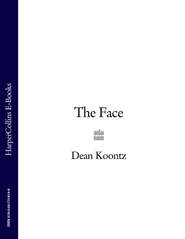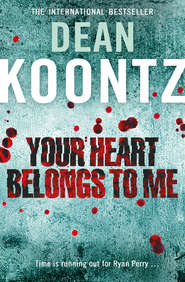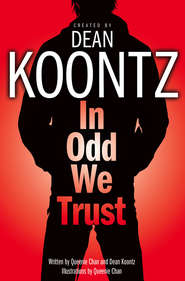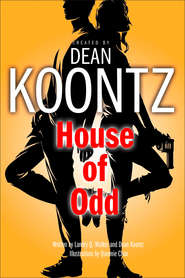По всем вопросам обращайтесь на: info@litportal.ru
(©) 2003-2025.
✖
Saint Odd
Автор
Год написания книги
2019
Настройки чтения
Размер шрифта
Высота строк
Поля
Any responsible dermatologist would have chastised me for speeding barefaced through this arid wasteland. For many reasons, however, there was little chance that I would live to celebrate my twenty-third birthday, so looking prematurely aged two decades hence didn’t worry me.
This time I heard the Escalade coming, shrieking like some malevolent machine out of a Transformers movie, running dark once more. Sooner than I hoped, the driver switched on the headlights, which flared in my mirrors and washed the pavement around me.
Closer than fifty feet.
The SUV was obviously souped. This wasn’t an ordinary mama-takes-baby-to-the-playground Caddy. The engine sounded as if it had come out of General Motors by way of Boeing. If he intended to run me down and paste me to the Caddy’s grille—and evidently he did—I wouldn’t be able to outrace whatever customized engine made him king of the road.
Having tricked up his vehicle with alternate, multi-tonal horns programmed with pieces of familiar tunes, he now taunted me with the high-volume song-title notes of Sonny and Cher’s “The Beat Goes On.”
The Big Dog boasted a six-speed transmission. The extra gear and the right-side drive pulley allowed better balance and greater control than would the average touring bike. The fat 250-millimeter rear tire gave me a sense of stability and the thirty-four-degree neck rake inspired the confidence to stunt a little even though I was approaching triple-digit speeds.
Now he serenaded me with the first seven notes of the Kingsmen’s “Louie Louie.” And then again.
My one advantage might be maneuverability. I slid lower in the seat, so that the arc of the windshield sent the wind over my helmet, and I made more aggressive use of the three-lane highway, executing wide serpentine movements from shoulder to shoulder. I was low to the ground, and the Escalade had a much higher center of gravity than the Big Dog; if the driver tried to stay on my tail, he might roll the SUV.
Supposing he was smart, he should realize that by not mimicking me, by continuing arrow-straight, he could rapidly gain ground as I serpentined. And with easy calculation, he could intersect me as I swooped from side to side of the road.
The third blast of “Louie Louie” assured me that either he wasn’t smart or he was so wasted that he might follow me into a pit of fire before he realized what he had done. Yet another programmed horn blared several notes, but I didn’t recognize the tune, though into my mind came the image of that all-but-forgotten rocker Boy George.
When brakes caterwauled, I glanced back to see the Escalade listing, its tires smoking, as the driver pulled the wheel hard to the right to avoid going off the north side of the pavement. Carving one S after another down the straightaway, I cornered out of the current curve, grateful for the Big Dog’s justly praised Balance Drive, and swooped into the next. With another squeal, the Caddy’s tires laid a skin of hot rubber on the blacktop as the driver pulled hard to the left. The vehicle nearly skidded off the south shoulder of the roadway, listing again but, as previously, righting itself well before it tipped over.
Resorting to his basic horn, the driver made no attempt at a tune this time, but let out blast after blast as if he thought he could sweep me off the bike with sound waves.
Recounting this, I might convey the impression that I remained calm and collected throughout the pursuit, but in fact I feared that, at any moment, I would regret not having worn an adult diaper.
In spite of whatever drugs or beverages had pushed the SUV driver’s CRAZY button and filled him with murderous rage, he retained just enough reason to realize that if he continued to follow my lead, he would roll the SUV. Arrowing down the center of the three lanes, he regained the ground that he’d lost, intending to intersect my bike between connecting curves of my flatland slalom.
The Big Dog Bulldog Bagger wasn’t meant to be a dirt bike. The diet that made it happy consisted of concrete and blacktop, and it wanted to be admired for its sleek aerodynamic lines and custom paint job and abundant chrome, not for its ruggedness and ability to slam through wild landscapes with aplomb.
Nevertheless, I went off-road. They say that necessity is the mother of invention, but it is also the grandmother of desperation. The highway was raised about two feet above the land through which it passed, and I left the shoulder at such speed that the bike was airborne for a moment before returning to the earth with a jolt that briefly lifted my butt off the seat and made my feet dance on the floorboards.
Hereabouts, the desert wasn’t a softscape of sand dunes and dead lakes of powdery silt, which was a good thing, because crossing ground like that, the Big Dog would have wallowed to a halt within a hundred yards. The land was mostly hard-packed by thousands of years of fierce sun and scouring winds, the igneous rocks rich with feldspar, treeless but in some places hospitable to purple sage and mesquite and scraggly plants less easily identified.
Jacked up on oversize tires, more suited to going overland than was my bike, the four-wheel-drive Escalade came off the highway in my wake. I intended to find a break in the land or an overhanging escarpment deep enough to conceal me, or a sudden spine of rock, anything I could use to get out of sight of my lunatic pursuer. After that, I would switch off my headlights, slow down significantly, travel by moonlight, and try as quickly as possible to put one turn in the land after another between me and him. Eventually I might find a place in which to shelter, shut off the bike, listen, and wait.
Suddenly a greater light flooded across the land, and when I looked back, I saw that the Escalade sported a roof rack of powerful spotlights that the driver had just now employed. The desert before me resembled a scene out of an early Steven Spielberg movie: a remote landing strip where excited and glamorous scientists from a secret government agency prepared to welcome a contingent of benign extraterrestrials and their mother ship. Instead of scientists and aliens, however, there was some inbred banjo player from Deliverance chasing me with bad intentions.
In those harsh and far-reaching streams of light, each humble twist of vegetation cast a long, inky shadow. The pale land was revealed as less irregular than I’d hoped, an apparent plain where I was no more likely to find a hiding place than I would a McDonald’s franchise complete with a playground for the tots.
Although my nature was to be optimistic, even cheerful, in the face of threat and gloom, there were times, like this, when I felt as though the entire world was death row and that my most recent meal had been my last one.
I continued north into the wilderness rather than angle back toward the highway, assuring myself that it wasn’t my destiny to die in this place, that I would find refuge ahead. My destiny was to die thirty miles or so from here, in the town of Pico Mundo, not tonight but tomorrow or the day after, or the day after that. Furthermore, I wouldn’t die by Cadillac Escalade; my end would be nothing as easy as that, nothing so quick and clean. Having argued myself into a fragile optimism, I sat up straight in my seat and smiled into the teeth of the warm night air.
As the SUV gained on me, the psycho driver resorted to one of his custom horns again. This time I recognized the title notes of “Karma Chameleon” by Culture Club, which had been fronted by Boy George. The song seemed so apt that I laughed; and my laughter would have buoyed me if it hadn’t sounded just a little insane.
The nitrogen-gas-charged shocks, the rubber-isolated floorboards, and the rubber handgrips all contributed to a smoother off-road ride than I had anticipated, but I expected that I was headed for one kind of mechanical failure or another, or for a collision with an unseen thrust of rock that would dismount me, or a community of rattlesnakes that, flung into the air in the midst of copulation, would rain down upon me, hissing.
I was suffering a brief remission in my characteristic optimism.
Ahead, a long but slight slope led to a narrow band of blackness before the Escalade’s lights revealed a swath of somewhat higher land that shimmered like a mirage. I couldn’t be sure what I was seeing; the sight was no less baffling than an abstract painting composed of geometric forms in pale beige and black, but in case it might be what I needed, I accelerated.
I had to weave among bushy clumps—a colony of pampas grass—that were half dead from too little water, their narrow five-foot recurved blades perhaps sharp enough to cut me, the numerous tall feathery panicles waving like white flags of surrender.
Evidently the nutcase pursuing me did not belong to the Sierra Club, because the Escalade barreled through the pampas grass without hesitation, leaving a path of crushed and shredded vegetation, gaining fast on me.
The ceaselessly repeated signature notes of “Karma Chameleon” and the roar of the SUV’s pumped-up engine were so loud, I knew that it must be close, maybe ten feet behind me. I didn’t dare glance back.
With but three or four seconds to make the right move, I saw that my suspicion about the terrain ahead was correct. I hung a hard right just before the brink.
The Big Dog fishtailed, the rear tire chewing away the lip of the abyss for a moment before it got traction.
Whether the driver’s attention suddenly shifted to the land ahead, whether he remained intently focused on me, in either case the Escalade had too much mass and momentum to come to a stop in time, and it was far less maneuverable than my bike. The wind of its passage swirled dust and dry bits of desert vegetation over me, and the big SUV launched off the rim of the ravine, still blaring “Karma Chameleon” as it briefly took flight.
With its four-piston billet calipers, the Big Dog could stop on a dollar if not a dime. I propped it with the kickstand and swung off and stood at the brink as the spotlight-equipped Caddy, now dropping nose-down like a bomb, illuminated its terminal destination.
Carved by millennia of flash floods and Mojave winds and seismic activity, the crevasse appeared to be about thirty feet wide at the top, less than ten at the bottom, about fifty feet deep. The plunging SUV tested the bedrock at the bottom, and the bedrock won. The last title note of the Culture Club tune came an instant before the crash of impact, the vehicle lights went out, and in the sudden darkness, the SUV shed pieces of itself, which rattled and clattered across the rocks.
I said, “Wow,” which isn’t witty enough for movie dialogue, but it’s what I said. I’m no Tom Cruise.
After a few seconds of darkness, the fire bloomed. It wasn’t an explosion, only low capering flames that quickly danced higher, brighter. The ravine proved to be a trap for tumbleweed that mounded along its bottom, and the spherical masses burst into flame faster to the west of the wreckage, apparently the direction in which gasoline spilled from the ruptured tank.
The walls of the ravine were steep but navigable on foot. The stone shaled away treacherously as I quickly sidled down with all the grace of—I don’t know why this unlikely image occurred to me at the time—a penguin on stilts. Too many years of watching old Warner Bros. cartoons by Chuck Jones can instill in you a silliness gene by proxy.
Perhaps equally silly—I was in my Good Samaritan mode. The driver had tried to kill me, sure, but his homicidal rage might have been the consequence of inebriation, and he might have been a peach of a guy when he was sober. I couldn’t let him bleed or burn to death just because of his idiocy behind the wheel of the SUV. Sometimes I am hampered by having a moral code, but I have it nonetheless, like a burr under the brain, with no way to pluck it out.
Fire flared to both sides of the Escalade, and lesser flames crawled under it, but the interior wasn’t yet ablaze. There were so many tinder-dry tumbleweeds that the ravine would be aglow for quite a while.
As I neared the vehicle, I saw painted on its tailgate neatly formed characters in a pictographic language reminiscent of ancient Egyptian hieroglyphics, white against the black paint. I halted and reconsidered the meaning of the encounter with the unknown driver.
A couple of months earlier, on a mountain in Nevada, I had found it necessary to explore a well-guarded estate where, as it turned out, kidnapped children were being held for the purpose of ritual murder by a satanic cult. Before I found the kids, I discovered a stable filled with antique breakfronts instead of horses, and in those breakfronts had stood thick glass jars the size of crocks, filled with a clear preservative, the lids fused in place with an annealing torch. In those jars were souvenirs of previous human sacrifices: severed heads, wide-eyed and open-mouthed, as if in the grip of eternal shock and terror, and on every forehead a different line of a pictographic language exactly like that on the tailgate of the Escalade.
Small-town boy meets big-time evil.
The driver of the Escalade hadn’t encountered me by chance. He had learned what route I was taking, when I would take it, and he’d set out in pursuit of me, no doubt intending to avenge the damage I had done to the cult. I’d killed a number of them. But their resources were impressive—in fact otherworldly—and we were far from finished with each other.
My code of conduct didn’t require me to save the lives of vicious murderers any more than it required me to feed myself to a shark just because the shark happened to be hungry. In fact, I felt obligated to kill murderous sociopaths if that was the only way to prevent them from slaughtering more innocents. Usually, that turned out to be the only way, because few of their kind responded well to reason or to stern warnings, or to the wisdom of the Beatles, which tells us that all we need is love.
The doors of the Escalade had buckled but hadn’t popped open, and if anyone had clambered out of a shattered window, I had not seen him. The driver—and passenger, if there was one—were all but certainly still inside. Maybe dead. At least badly injured. Perhaps unconscious.
As I retreated, the crackling fire under the vehicle abruptly found its way inside, and with a whoosh, the interior filled with flames. I saw no thrashing shadows in the Escalade and heard no screams.
I couldn’t imagine how they had known I was going home to Pico Mundo or when I would make the trip, or what I would be driving. But as I had unusual talents, abilities, and connections, so did they. I might never learn how they had located me. What mattered now was that they were looking for me; and if they had found me once, they could find me again.
They wouldn’t have tried to find me and kill me en route, however, if they had known where I would be staying when I got to Pico Mundo. Instead, they would have waited for me there and cut me down when I arrived. The safe house waiting for me was still safe.
Climbing the shale slope proved more difficult than the descent had been. I kept glancing behind me, half expecting to discover a pursuer, some grotesque nemesis with hair afire and smoke seething from his twisted mouth.
At the top, I looked back and saw that the flames, a bright contagion, had spread maybe sixty yards to the west, from one crisp tumbleweed to another. The shale must have been veined with pyrite, for in the walls of the ravine, in the throbbing firelight, ribbons of yellow glimmered brighter than the surrounding stone. The burning Escalade screaked and twanged. As its metallic protests echoed and re-echoed along the crevasse, they were distorted, changed, until I could almost believe that I was hearing human voices, a suffering multitude crying out below.











